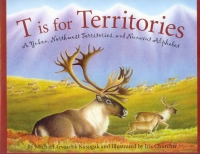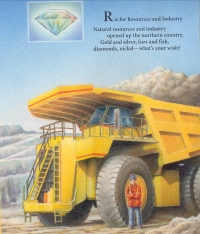| ________________
CM . . .
. Volume XX Number 1. . . .September 6, 2013 
 |
T is for Territories: A Yukon, Northwest Territories, and Nunavut Alphabet.
Michael Arvaarluk Kusugak. Illustrated by Iris Churcher.
Ann Arbor, MI: Sleeping Bear Press (Distributed in Canada by Nelson Education), 2013.
40 pp., hardcover, $18.95.
ISBN 978-1-58536-207-3.
Subject Headings:
Yukon-Juvenile literature.
Northwest Territories-Juvenile literature.
Nunavut-Juvenile literature.
Alphabet books.
Grades 2-8 / Ages 7-13.
Review by Nicole Dalmer.
*** /4
|
| |
|

excerpt:
T is for Tundra. Not one tree as far as you can see, from rocky hills to arctic seas. Grasses, lichens, and Labrador tea, home to mosquitoes and bumblebees.
The arctic tundra is located across northern Canada, Alaska, and Siberia, near the North Pole. There, the tallest plants are dwarf willows. There are no trees. Thirty centimetres below the surface, the ground is frozen so trees cannot grow roots. This frozen ground is called permafrost. This means the ground has remained frozen for at least two years in a row. In some areas the permafrost is all ice and, when it melts, the ground turns to mud and sinks.
The tundra is rocky. There are long, high ridges that were formed when Ice Age glaciers flowed along the ground, gouging out valley. In the short summer months, the grasses grow and the tundra fields are covered in tiny, colourful arctic flowers: purple saxifrage, arctic poppies, mountain avens, cottongrass, and many others. Caribou feed on the lichens, people burn tingaujat (black, curly tundra moss) to make tea, and tall grasses grow on mounds of sandy soil where siksiks (arctic ground squirrels) dig their holes.
Using the letters of the alphabet, Kusugak introduces readers to fascinating facts, details and images of life, culture and traditions in the three Canadian territories. Combining stunning illustrations and descriptive text, each of the 26 letters is accompanied by both a short rhyme introducing each topic as well as several sidebar paragraphs that go into greater detail about the depicted subject.
Born in Hudson Bay, storyteller and author Michael Arvaarluk Kusugak offers keen and authentic insights into the history, politics and developments of Yukon, Northwest Territories and Nunavut. While expected topics such Skookum Jim Mason and the Klondike Gold Rush, the Arctic Ocean, Caribou and Baffin Island appear in T is for Territories, itís the unique inclusions of descriptions of Qaggi (a feast of caribou and fish), syllabics and literacy, and umiaq (a wooden framed boat) that set this book apart. This picture book contains an impressive amount of information about the various facets of northern Canadian life, both past and present.
 This alphabetical journey is suitable for a wide range of readers. Younger or less experienced readers will be able to easily follow the short rhymes associated with each letter and can use Iris Churcherís colourful and realistic illustrations as a guide. Older readers will appreciate the accompanying paragraphs that offer comprehensive explanations about the different topics being discussed, making this resource a visually appealing and educational tool.
This alphabetical journey is suitable for a wide range of readers. Younger or less experienced readers will be able to easily follow the short rhymes associated with each letter and can use Iris Churcherís colourful and realistic illustrations as a guide. Older readers will appreciate the accompanying paragraphs that offer comprehensive explanations about the different topics being discussed, making this resource a visually appealing and educational tool.
Readers are introduced to a variety of customs, languages and fascinating facts throughout this read. At times, the authorís passion and knowledge for the 26 topics explored are muddled by the overly detailed and wordy paragraphs that accompany each letter. While a minor observation, the amount of information and topics the author relates to each letter can be, at times, overwhelming. Overall, the impressive illustrations and the unique northern Canadian topics and themes covered by T is for Territories render this read a must-have for younger Canadian readers.
Recommended
Nicole Dalmer is a recent graduate of the Master of Library and Information Studies program and is now a Public Service Librarian at the Herbert T. Coutts Education and Physical Education Library at the University of Alberta in Edmonton, AB.

To comment
on this title or this review, send mail to cm@umanitoba.ca.
Copyright © the Manitoba Library Association. Reproduction for personal
use is permitted only if this copyright notice is maintained. Any
other reproduction is prohibited without permission.
NEXT REVIEW |
TABLE OF CONTENTS FOR THIS ISSUE
- September 6, 2013.
AUTHORS |
TITLES |
MEDIA REVIEWS |
PROFILES |
BACK ISSUES |
SEARCH |
CMARCHIVE |
HOME |

 This alphabetical journey is suitable for a wide range of readers. Younger or less experienced readers will be able to easily follow the short rhymes associated with each letter and can use Iris Churcherís colourful and realistic illustrations as a guide. Older readers will appreciate the accompanying paragraphs that offer comprehensive explanations about the different topics being discussed, making this resource a visually appealing and educational tool.
This alphabetical journey is suitable for a wide range of readers. Younger or less experienced readers will be able to easily follow the short rhymes associated with each letter and can use Iris Churcherís colourful and realistic illustrations as a guide. Older readers will appreciate the accompanying paragraphs that offer comprehensive explanations about the different topics being discussed, making this resource a visually appealing and educational tool.